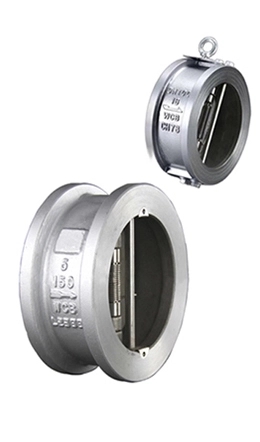Wafer check valves are compact, efficient valves designed to prevent backflow in unidirectional piping systems. Known for their slim profile and simple operation, they are a popular choice in space-constrained applications across various industries. At KFTE Valves, we offer high-quality wafer check valves tailored for reliable performance. This guide explores the design, function, advantages, and applications of wafer check valves, answering common questions to help you select the right valve for your needs.
A wafer check valve is a type of non-return valve that fits between two pipe flanges, ensuring one-way fluid flow while preventing backflow. Its thin, "wafer-like" design eliminates the need for additional mounting hardware, making it ideal for compact installations. The valve features a disc or plate that opens under forward flow pressure and closes under reverse pressure, providing a tight seal. For example, a Dual Plate Wafer Check Valve is often used in HVAC systems for its quick response and durability.

The working principle of a wafer check valve is simple yet effective:
Forward Flow: When fluid flows in the intended direction, the upstream pressure lifts the disc or plate, allowing passage through the valve.
Reverse Flow: When flow reverses or pressure drops, the disc (often spring-assisted) returns to the seat, sealing the valve to prevent backflow.
This automatic, self-activating mechanism requires minimal system pressure (typically 2–4 PSI) to operate, ensuring rapid response to prevent issues like water hammer. A Spring-Loaded Wafer Check Valve enhances sealing for viscous fluids.
Wafer check valves come in various designs to suit different applications:
Single Disc Wafer Check Valve: Features a single disc for simple, cost-effective backflow prevention in standard systems like water treatment.
Dual Plate Wafer Check Valve: Uses two plates that fold inward, reducing water hammer and offering faster closure, ideal for high-flow systems like oil and gas.
Spring-Loaded Wafer Check Valve: Incorporates a spring for rapid disc closure, suitable for applications with frequent flow changes, such as chemical processing.
Wafer check valves offer several benefits compared to other check valves, such as swing check valves:
Space-Saving Design: Their slim profile fits tight spaces, reducing installation footprint.
Easy Installation: Sandwiched between flanges, they require no additional supports, simplifying setup.
Quick Response: Rapid disc closure prevents water hammer, protecting system components.
Low Pressure Loss: Optimized flow paths minimize pressure drop, enhancing system efficiency.
Cost-Effective: Lower material and maintenance costs make them economical for various applications.
Wafer check valves are versatile, used in industries where unidirectional flow and space constraints are critical:
Industrial Water Treatment: Preventing backflow in pumping systems to protect equipment.
HVAC Systems: Ensuring one-way flow of heating or cooling media for efficient temperature control.
Oil and Gas Pipelines: Maintaining flow direction in high-pressure pipelines to prevent equipment damage.
Chemical Processing: Protecting sensitive systems from reverse flow of corrosive fluids.
Marine Applications: Managing ballast and bilge water in ship systems.
Food and Beverage: Ensuring hygienic, unidirectional flow in processing lines.
| Feature | Wafer Check Valve | Swing Check Valve |
|---|---|---|
| Design | Compact, fits between flanges | Larger, requires more space |
| Installation | Easy, no additional hardware | Requires spacers or flanges |
| Flow Response | Quick, reduces water hammer | Slower, may cause water hammer |
| Applications | Space-constrained systems | High-flow, full-bore systems |
| Pressure Drop | Low | Minimal |
Wafer check valves are available in various sizes and materials to meet diverse needs:
Size Range: 1/2″ to 48″ (DN15–DN1200), accommodating small to large pipelines.
Pressure Range: Class 150–2500 (PN20–PN420), suitable for low to high-pressure systems.
Body Materials: Stainless steel, carbon steel, PVC, ductile iron for corrosion resistance.
Disc Materials: Stainless steel, bronze, or composite materials for durability.
Seal Materials: EPDM, Viton, or PTFE for reliable sealing in various media.
Material selection depends on the fluid's chemical properties, temperature, and pressure. For example, a stainless steel Wafer Check Valve is ideal for corrosive chemical applications.
Proper installation and maintenance ensure optimal performance of wafer check valves:
Check Flow Direction: Align the valve with the indicated flow direction to ensure proper operation.
Flange Alignment: Ensure flanges are properly aligned to avoid stress on the valve body.
Bolt Tightening: Tighten flange bolts evenly to maintain a secure seal.
Regular Cleaning: Remove debris to prevent blockages and ensure smooth disc movement.
Seal and Spring Inspection: Check seals and springs periodically, replacing worn components to maintain sealing integrity.
At KFTE Valves, we specialize in high-quality wafer check valves designed for reliability and efficiency. Our valves, including Dual Plate Wafer Check Valves and Spring-Loaded Wafer Check Valves, are engineered for diverse applications, from water treatment to oil and gas. With robust materials and precision manufacturing, our solutions ensure long-term performance and minimal maintenance. Explore our wafer check valve catalog or contact our team at KFTE Valves for expert guidance on your flow control needs.
Wikipedia. (2025). Check Valve. An overview of check valve types and functions. Available at: https://en.wikipedia.org/wiki/Check_valve.
Valve World. (2024). Check Valves in Industrial Applications. A resource on check valve types and uses. Available at: https://www.valve-world.net/check-valves.